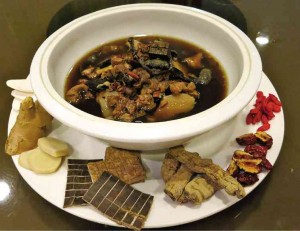
Tony’s Restaurant is a humble eatery in Caloocan City. What makes it grand is its food. Patrons flock to it.
When we went there, there were many diners and it was only 9:30 in the morning—when the food display was but a third full!
The restaurant is famous all over Caloocan and those who are in the know are aware that it serves Soup #5, the famous aphrodisiac dish said to be made made from bull’s balls.
Ramon Go, whose taste buds are very reliable, introduced me to the owner, Vicente Que Jr.
Que said the soup is a recipe from the olden times. It is called #5 because it has five main ingredients—sea cucumber, pork tendon, duck, pig intestines and pork leg with sibut (a packet of four Chinese herbs).
But where’s the sex organ of the bull that the soup is supposedly famous—or notorious—for?
Que said the original recipe had no beef because the old Chinese didn’t eat beef. The recipe in China called for duck, but Que uses chicken.
“The best time to enjoy it is when the weather is cold,” Que said, “because the soup has a warming effect on the body. Sibut is known to make you strong. Pampalakas.”
Que said he has been working in the kitchen ever since the restaurant opened four decades ago. As a young man, he thought it would be best to work with his parents, Vicente Que Sr. and Amparo Bagtas, than with anyone else. So he learned all he could, the best dishes and techniques, from his parents who were excellent cooks.
How to cook Soup #5:
Bring 6 liters of water to a boil and add 6 packs of sibut.
Boil 10 minutes until the soup turns to a dark rich brown.
Add 1 pork leg (front) chopped and let the stock simmer over low heat. Cook until the pork is tender.
Once the pork is tender, add 1 whole duck or chicken, chopped up; and 2 kilos of pork intestines cut into bite-size pieces.
(To prepare the latter, mash intestines with salt and wash very well. Bring intestines to a boil and throw away the water.)
Also add 1 kilo sea cucumber, sliced, and 1 kilo pork tendon.
Simmer again over low heat until the meats are cooked and tender. Season the soup with vetsin.
“Our soup is good because it is made in big batches; that is what makes it more flavorful,” said Que.
His pork rib soup with fish balls are nice too, simple yet tasty. Tony’s Restaurant also offers adobo ribs, paksiw na lechon and kiampung. The day I visited, the oyster kilawin was very fresh.
Asked why people from all walks of life keep going back to Tony’s, he replied, “It is perhaps the menu—a mix of the Filipino and Chinese dishes.”
“Our food is also very reasonably priced,” he added. A hefty bowl of Soup #5 only costs P80!
Asked the secret of his success, Que said he keeps things simple. “I have a very simple business, but I have been able to build a house, buy cars and send my children to school.”
Of course, a great part of his success owes to hard work and perseverance.
At 62, he still keeps at it, even going to the market to procure goods and ingredients for the kitchen. When this interview ended, he thanked me and reiterated, “Walang sikreto! Sipag lang!” (There’s no secret really, it’s just hard work!)
Call 3639920.
Hong Kong-style
Hai Shin Lou, one of my favorite destinations for exquisite Cantonese food, has its own version of Soup #5.
According to restaurant manager Ben Chong, if you asked for Soup #5 in Hong Kong, no one would know.
“We call it healthy soup, because it is good for the health, body circulation and, of course best for virility. It is best taken in the afternoon or evening and a maximum of two to three times a week. You will find this soup in small eateries but never in fancy restaurants.”
The herbs for Hai Shin Lou’s version of the soup directly come from Hong Kong.
This version is very different. It tastes woody, deep and very herbal. But it is quite popular with men 50 and above, said Chong.
It is best to order one day in advance, the manager said.
Hai Shin Lou has other healthy soups such as dried snail and chicken (eyes) and kayyong mushroom.
Call 8925148, 8138491.
Chef Tomy Yau’s Soup #5
Chinese herbal mix: 25 g baquig, 25 g toochun; 6 waisan, sliced; 5 g guychi
8 pc red dates (no seeds)
200 g ox organ
100g native chicken
10 g Chinese ham
Ginger, sliced
Chinese yellow wine
1.5 k water
Wash the ox organ very well and boil for 5 minutes. Slice the organ.
Boil the organ slices for 3 hours with ginger until tender. Discard liquid.
Add new sliced ginger and Chinese wine and stir fry. Add the native chicken and Chinese ham.
Combine all the ingredients in a bowl and steam in a Chinese steamer for 8 hours.
Have a great Valentine!